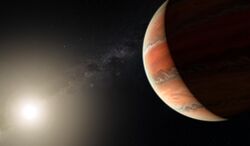Chemistry:Titanium oxide
From HandWiki

Titanium oxide may refer to:[2]
- Titanium dioxide (titanium(IV) oxide), TiO2
- Titanium(II) oxide (titanium monoxide), TiO, a non-stoichiometric oxide
- Titanium(III) oxide (dititanium trioxide), Ti2O3
- Ti3O
- Ti2O
- δ-TiOx (x= 0.68–0.75)
- TinO2n−1 where n ranges from 3–9 inclusive,[3] e.g. Ti3O5, Ti4O7, etc.
Reduced titanium oxides
A common reduced titanium oxide is TiO, also known as titanium monoxide. It can be prepared from titanium dioxide and titanium metal at 1500 °C.[4]
Ti3O5, Ti4O7, and Ti5O9 are non-stoichiometric oxides. These compounds are typically formed at high temperatures in the presence of excess oxygen.[5][6] As a result, they exhibit unique structural and electronic properties, and have been studied for their potential use in various applications, including in gas sensors, lithium-ion batteries, and photocatalysis.[6]
References
- ↑ "Inferno World with Titanium Skies - ESO's VLT makes first detection of titanium oxide in an exoplanet". https://www.eso.org/public/news/eso1729/.
- ↑ Wells A.F. (1984) Structural Inorganic Chemistry 5th edition Oxford Science Publications ISBN:0-19-855370-6
- ↑ Greenwood, Norman N.; Earnshaw, Alan (1997). Chemistry of the Elements (2nd ed.). Butterworth-Heinemann. ISBN 978-0-08-037941-8.
- ↑ Holleman, Arnold Frederik; Wiberg, Egon (2001), Wiberg, Nils, ed., Inorganic Chemistry, San Diego/Berlin: Academic Press/De Gruyter, ISBN 0-12-352651-5
- ↑ Kumar, Ashish; Barbhuiya, Najmul H.; Singh, Swatantra P. (2022-11-01). "Magnéli phase titanium sub-oxides synthesis, fabrication and its application for environmental remediation: Current status and prospect" (in en). Chemosphere 307: 135878. doi:10.1016/j.chemosphere.2022.135878. ISSN 0045-6535. PMID 35932919. Bibcode: 2022Chmsp.307m5878K. https://www.sciencedirect.com/science/article/pii/S0045653522023712.
- ↑ 6.0 6.1 Soleimani, Meisam; Ghasemi, Jahan B.; Badiei, Alireza (2022-01-01). "Black titania; novel researches in synthesis and applications" (in en). Inorganic Chemistry Communications 135: 109092. doi:10.1016/j.inoche.2021.109092. ISSN 1387-7003. https://www.sciencedirect.com/science/article/pii/S138770032100647X.
 |

